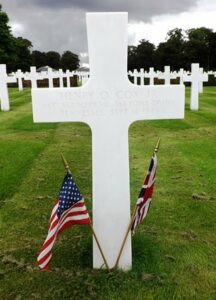Llanyre, or Llanllyr in Welsh, is a small village situated to the west of Llandrindod Wells, in the county of Radnorshire, on the B4539 road from Newbridge-on-Wye. The village contains a Parish Church, dedicated to St. Llyr, and opposite is the Parish War Memorial, in the form of a stone cross, next to which is a memorial to the crew of an American bomber which crashed in the area during World War Two.
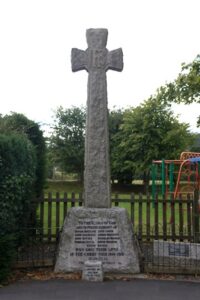
The Great War, 1914-1918
Thomas Adrian Buckland, MiD, Lieutenant, Norfolk Regiment. Thomas was born in Sydney, Australia on 29 August 1892, the son of Thomas Buckland and Ada Lucy Buckland. His father was a successful merchant and by 1901 the family had moved to Ascot, Berkshire. Thomas was educated at Hazelwood School until December 1905 when he went to Eton, then entered Trinity College Cambridge on 25 June 1911, gaining his BA. Following the outbreak of war, he was commissioned into the Norfolk Regiment on 25 September 1914 and embarked for France with the 7th Battalion, Norfolk Regiment aboard the SS Invicta on 30 May 1915, landing at Boulogne the following day. The battalion was attached to 35 Brigade, 12th Division and initially took over the line at Ploegsteert Wood. After gaining some experience in trench warfare the division moved south in order to join the offensive at Loos. Thomas was wounded in the back by shrapnel on 4 October but remained at his post. Nine days later, his battalion was ordered to attack a position known as The Quarries, but came under heavy fire and failed to make its objective. Thomas was reported as missing during the attack that day, but on 19 October a patrol sent out by the 9th Essex came across him, lying in No Man’s Land, badly wounded but still alive. The Germans opened fire on the patrol, forcing the men to retreat, and when they went out again that night, they found Thomas had been shot dead. He was 23 years old when he died that day, and is commemorated on the Loos Memorial, France. He was mentioned in Field Marshall Sir John French’s despatches of 30 November 1915 for: ‘gallant and distinguished service in the field.’ Thomas is also commemorated on the war memorial at Trinity College, Cambridge, on the memorial at Eton College and on the Australian War Memorial, Canberra.
John Charlton, Private, S/11326, Argyll and Sutherland Highlanders. John appears to have been born as John Lewis in 1887. He was adopted by Robert John Charlton and Agnes Charlton. His father was a gardener at Doldowlod. John enlisted at Dunfermline into the Argyll and Sutherland Highlanders and landed in France on 1 October 1915, before being posted to the 2nd Battalion, Argyll and Sutherland Highlanders, which was attached to 19 Brigade. The brigade was by then attached to the 2nd Division but on the following month was attached to the 33rd Division. The Division had moved to France during November 1915, and saw its first major action during the Battles of the Somme, from July 1916 onwards. Early in 1917 it had moved to the Arras sector in readiness to take part in the forthcoming Battle of Arras. The battle opened on 9 April 1917 and the most famous success was to the north, with the successful Canadian assault on the Vimy Ridge. John was killed during the Second Battle of the Scarpe, on 24 April 1917aged 29. He has no known grave and is commemorated on the Arras Memorial, France. John is also commemorated on the Rhayader war memorial.
Evan Thomas Davies, Private, 51663, Cheshire Regiment. Evan was born at Faldlace Farm, Llanyre in 1891, the son of Evan and Sarah Jane Davies. He worked as a waggoner for David Mills at Newbridge-on-Wye prior to the war and enlisted at Knighton into the King’s Shropshire Light Infantry on 31 May 1917. He was posted to Pembroke Dock for training with the 3rd Battalion, KSLI and after training embarked at Southampton for France on 19 October 1917. Upon arrival in France he briefly joined the 5th Battalion, KSLI, but within days was transferred to the 15th Battalion, Cheshire Regiment. The battalion was attached to 105 Brigade, 35th Division, and was at Ypres, taking part in the Battle of Passchendaele. By the spring of 1918 the division was back on the Somme, and fought at the First Battle of Bapaume, during the German Offensive, and took part in a fighting withdrawal to Bouzincourt, where it was relieved by the 38th (Welsh) Division. The division remained in the area over the coming weeks, and after a spell in reserve moved back into the front to the left of the 38th Division. Evan was badly wounded in the thigh during an assault on Aveluy Wood on 1 June 1918. He was evacuated to the 107th Field Ambulance before being sent to the Base Hospital at Le Treport where he died of his wounds on 5 June 1918, aged 26. Evan is buried in Mont Huon Military Cemetery, Le Treport, France. He is also commemorated on the Newbridge-on-Wye War Memorial.
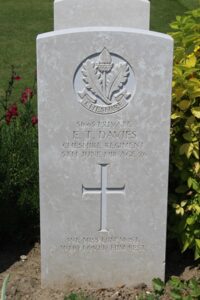
John Morgan Davies, Private, 38513, Royal Welsh Fusiliers. John was the son of Ann Davies, of 4, Brookland Cottage, Cefnllys. He married Margaret Ann Evans at Holy Trinity Church Cefnllys on 30 April 1913 and the couple moved to Bargoed, where John had found work as a Collier. He enlisted at Bargoed into the 16th (Cardiff City) Battalion, Welsh Regiment on 25 February 1915 and was posted to Colwyn Bay to train with the battalion. The 16th Welsh embarked for France with the 38th (Welsh) Division on 2 February 1915, but John remained in Britain, transferring to the 2nd (Garrison) Battalion, Royal Welsh Fusiliers. He embarked with the battalion at Devonport on 6 March 1916 for service in Alexandria. After four months in Egypt he was posted to the BEF in France, embarking at Alexandria on 12 July 1916 and upon arrival in France joined the 10th Battalion, Royal Welsh Fusiliers. The battalion was attached to 76 Brigade, 3rd Division and was on the Somme at the time John arrived and had taken part in terrible fighting in Delville Wood. John joined up with the battalion in tents at Mericourt l’Abbe. On 14 August the battalion marched out of camp to Talus Bois and on 16 August 1916 took over the line at Casement and Dublin Trenches. John was unfortunately one of three men killed when the 10th RWF took over their new positions that day. He was 38 years old and is commemorated on the Thiepval Memorial, France. He is also commemorated on the Llandrindod Wells and Rhayader war memorials.
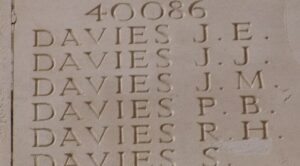
John Lewis, Private, M2/200138, Army Service Corps. John was the son of Evan and Anne Lewis, of Llanyre. He had married his wife, Florence Kate Lewis prior to the war and the couple had two children, living at Sunny Bank, Batheaston. John enlisted at Hammersmith into the Army Service Corps and was posted to France, joining the Motor Transport. Nothing else is currently known of his military service, but John was killed in action at Ypres on 23 June 1917, aged 36. He is buried in Lijssenthoek Military Cemetery, Belgium.
Stanley Mason, Private, 8118, Herefordshire Regiment. Stanley was born at Cilfynydd, the son of George and Maria Mason. By 1895 the family had moved to Brickyard Cottage, Newbridge On Wye. Stanley worked as a railway platelayer for the Cambrian Railway prior to enlisting at Newbridge into the 1/1st Battalion, Herefordshire Regiment. The battalion was attached to the North Wales Brigade, Welsh Division at Bedford. On 13 May 1915 the formation became 158 Brigade, 53rd (Welsh) Division and on 16 July 1915 embarked at Devonport for Gallipoli. Stanley landed at Suvla Bay with the battalion on 9 August 1915. The division began to advance into the bush, but the situation was made difficult due to poor maps and no knowledge of the terrain and the advancing troops came under fire from the Turkish defenders. Stanley was wounded at some time soon after the landings and was evacuated by Hospital Ship to Mudros Island where he died of his wounds on 18 August 1915, aged 23. He is buried in East Mudros Military Cemetery, Greece. Stanley is also commemorated on the Cambrian Railways memorial at Oswestry.
James Meredith, Private, 55068, Royal Welsh Fusiliers. James was the son of Thomas and Anne Meredith, of Bwlch y Draith, Newbridge-on-Wye. He married Edith Eleanor Davies in 1913 and the couple had two children. James worked on his father’s farm prior to enlisting at Llandrindod Wells into the army and was posted to the Monmouthshire Regiment. Once he had completed his training, he was posted in France in 1916, where he was transferred to the 10th Battalion, Royal Welsh Fusiliers. The battalion was on the Somme attached to 76 Brigade, 3rd Division and took part in heavy fighting in Delville Wood throughout July. After a brief rest the division moved back into the Somme front at Serre and took part in the Battle of the Ancre later in the year. During February 1917 the division moved slightly north to the Arras sector to begin a routine tour in the trenches. James was killed in action at Arras on 28 February 1917, aged 34. The 10th RWF was relieved later that day, marching back to billets in Arras. James has no known grave and is commemorated on the Arras Memorial, France. He is also commemorated on the Newbridge-on-Wye War Memorial.
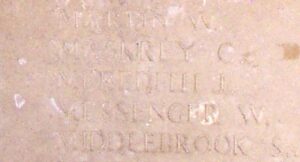
Thomas Thompson Pritchard, Second Lieutenant, Royal Flying Corps. Thomas was born at Knighton, Radnorshire in 1888, the son of Edward Jones Pritchard and Anne Pritchard (nee Evans). His mother was from Llanyre and Thomas had spent much of his youth with his aunt, Margaret Reynolds, at the Baskerville Arms, Clyro. Following the death of his father, the family moved to 30, Commercial Street, Gilfach Bargoed where Thomas worked as a baker. He enlisted into the Gloucestershire Hussars in January 1916 and became a despatch rider. He was commissioned as Second Lieutenant into the Royal Flying Corps in February 1917 and was posted to Yatesbury, in Wiltshire for pilot training. On 30 August 1917 Thomas was flying a B.E.2e, Serial B710 of 59 Training Squadron at Yatesbury when the aircraft stalled and spun out of control into the aerodrome, killing Thomas instantly. The remains of the 21-year-old were recovered from the wreckage and brought home for burial in St. Llyre’s Churchyard, Llanyre. Thomas is not commemorated on the Llanyre war memorial.
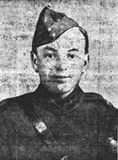
David Richard Rogers, Private, 239004, Herefordshire Regiment. David was the son of Price and Elizabeth Rogers, of Garter Hall, Llanyre. He worked on his fathers’ farm prior to enlisting at Disserth into the 1/1st Battalion, Herefordshire Regiment. The battalion was attached to the North Wales Brigade, Welsh Division at Bedford. On 13 May 1915 the formation became 158 Brigade, 53rd (Welsh) Division and on 16 July 1915 embarked at Devonport for Gallipoli. Following an arduous time at Gallipoli the division was evacuated from the Peninsula and moved to Egypt to join the EEF, where it garrisoned the Suez Canal for over a year. During March 1917 the EEF launched a series of offensives into Palestine to prise the region from Turkish rule. The 53rd (Welsh) Division played an important role in the three Battles of Gaza, helping to capture Jerusalem later that year. At the start of 1918 the plan for the EEF was now to capture the city of Jericho. From January the army started to advance towards the city, which fell at the end of February. The EEF continued its advance and on 9 March 1918 David was killed in action during an attack on Chip Hill, near Tel Asur. He was 22 years old and is buried in Jerusalem War Cemetery, Israel.
George Edwin Charles Rogers, Private, TR4/67895, South Wales Borderers. George was the son of John and Mary Ann Jane Rogers, of Bodkin Hall, Nantmel. He enlisted into the 53rd (Graduated) Battalion, South Wales Borderers and was posted to Kinmel Park for training. He had not been in the colours long before he took ill, and died of pneumonia in Kinmel Park Military Hospital on 30 September 1918, aged 18. His remains were brought home for burial in Carmel Congregational Chapelyard.
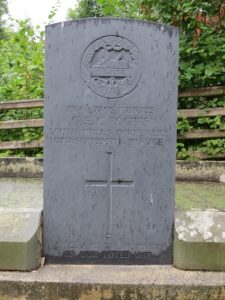
World War Two, 1939-1945
Martin Ricardo Gibson-Watt, DSC, Lieutenant, Royal Navy. Martin was born in Stroud in 1920, the son of Major James Miller Gibson-Watt and Marjorie Gibson-Watt (née Ricard). His father, from Nantmel and a descendant of the Scottish engineer James Watt, had served with the South Wales Borderers during the Great War, while his mother was the daughter of Henry and Adela Ricardo, of Gatcombe Park, and the couple moved to the Watt family home at Doldowlod, Llanyre after their marriage. Martin joined the Royal Navy prior to the war and passed as a Midshipman on 1 January 1938. His first wartime posting was as a Sub-Lieutenant aboard the D-class destroyer HMS Dainty. The destroyer took part in the Mediterranean convoys and had towed the disabled tanker Desmoulea to Suda Bay after it had been torpedoed by an Italian torpedo boat off Crete on 31 January. Dainty then returned to patrol the North African coast and on the afternoon of 24 February 1941 she had just left Tobruk with HMS Hasty when the ships were attacked by German Ju-88 bombers and Hasty was set ablaze, before sinking. Martin gained the award of the Distinguished Service Cross for his actions during the sinking of his ship. He was then promoted to Lieutenant and posted aboard the K-class destroyer HMS Kandahar. On 19 December 1941, Kandahar was part of British Force K, tasked to intercept an Italian convoy bound for Tripoli when she struck a newly laid Italian mine whilst attempting to rescue the stricken cruiser Neptune. Martin was one of 73 men killed in the explosion. The stricken Kandahar was scuttled the following day. Martin was just 21-years-old when he was killed on 19 December 1941 and is commemorated on the Plymouth Naval Memorial, Devon.
His brother James David Gibson-Watt served with the 3rd Battalion, Welsh Guards during the war, and gained the award of the Military Cross twice, the first in Tunisia and the second at Monte Cassino. He returned home to Doldowlod after the war and became a prominent politician and Member of Parliament.
Llanyre USAAF Memorial
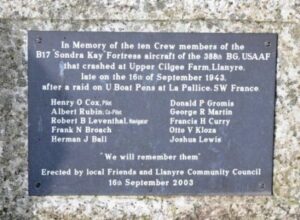
Next to the parish war memorial in Llanyre is a simple stone memorial, which was unveiled on 16 September 2003, to commemorate the lives of the ten crew members of an American ‘Flying Fortress’ who were killed when their aircraft crashed at Upper Cilgee Farm, Llanyre on 16 September 1943.
The crew were attached to the 562nd Bomb Squadron of the 388th Bomb Group, based at Knettishall, Suffolk. They had crossed the Atlantic in their aircraft before arriving at Knettishall on 16 June 1943. The crew had named their aircraft ‘Sondra Kay’ after the infant daughter of one of the crewmen.
The Crew of ‘Sondra Kay’ (c. IWM)
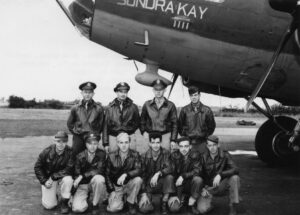
On 16 September 1943 the crew had been part of a large raid by the 488th Bomb Group on the German U-Boat pens at La Pallice, France and were returning to Knettishall when the weather deteriorated and the group became scattered. ‘Sondra Kay’ had been damaged during he raid and had sought permission to land at RAF Shobdon but became lost and crashed near Upper Cilgee Farm, Llanyre, killing all her crew of ten young men.
The crew of B-17 42-5906 ‘Sondra Kay’:
Pilot, 2nd Lieutenant Henry Oren Cox, Jr.
Co-Pilot, 2nd Lieutenant Albert Rubin.
Navigator, 2nd Lieutenant Robert Blonder Leventhal
Bombardier, 1st Lieutenant Frank Norman Broach Jr.
Engineer, T/Sergeant Herman Joseph Ball
Radio Operator, T/Sergeant Donald Paul Gromis
Ball Turret Gunner, S/Sergeant George Roscoe Martin
Waist Gunner, T/Sergeant Otto Victor Kloza
Waist Gunner, S/Sergeant Francis R. Curry
Top Gunner, S/Sergeant Joshua Manuel Lewis
The Grave of Henry Oren Cox at Cambridge American Cemetery
